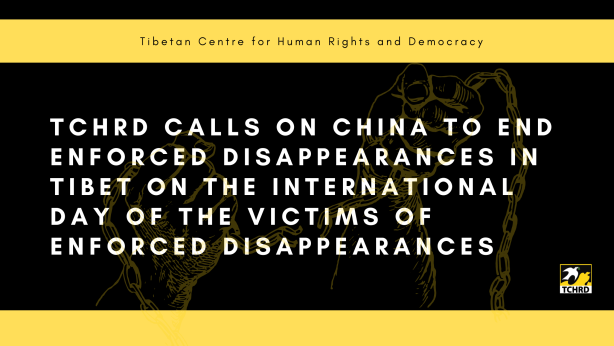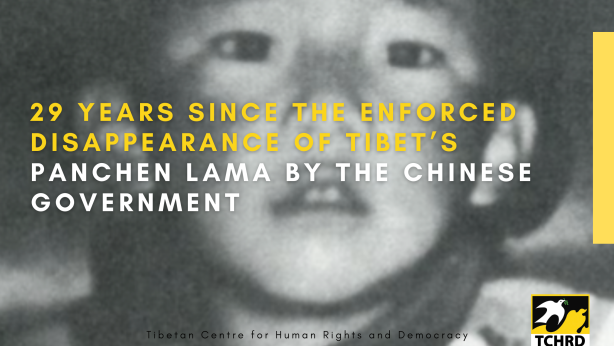China silent on enforced disappearance of Tibet’s Panchen Lama as TCHRD observes 22 years of Panchen Lama’s captivity with a new report on Tibet’s prisoners of conscience

Today is the 28th birthday of Tibet’s 11th Panchen Lama, Gedhun Choekyi Nyima, who went missing 22 years ago along with his parents after they were detained by Chinese officials in Tibet. The Panchen Lama’s case has become one of the world’s longest enforced disappearances, the answer to which is considered a top state secret by the Chinese government.
The last information on Panchen Lama’s condition became available on 6 September 2015 when Norbu Dhondup, an official from the United Front Work Department of Tibet Autonomous Region (TAR) responded to questions from the media that Panchen Lama was was living ‘a normal, happy life and receiving a good cultural education’ and that he ‘does not want to be disturbed.’ This brief and vague response was similar to earlier statements from Chinese leaders on the Panchen Lama. The fact is there is no evidence to corroborate this claim and is designed to deflect questions from the international community on the enforced disappearance of one of Tibet’s most important spiritual leaders.
The continued detention of Panchen Lama in secret is an act of enforced disappearance, a “serious international crime” that violates multiple human rights and fundamental freedoms enshrined in the Universal Declaration of Human Rights and other major international human rights instruments. During an enforced disappearance, the disappeared persons are potentially subjected to arbitrary arrest, extrajudicial detention, torture, inhuman treatment, and illegal executions. From the moment he or she is taken into custody, the victim is held incommunicado for days, weeks, or even years, without any contact or communication with his or her family members and relatives. The fact that the victim is completely isolated from the outside world and placed “outside the law” during the entire duration of his “disappearance” characterizes the act and process of enforced disappearances as extrajudicial, and thus criminal under international law. Under Chinese law, Article 34 of the constitution provides basic human rights including the right to vote and stand for election to all citizens who have reached the age of 18. The Panchen Lama is 28 years old and does not need Chinese protection to lead a normal life.
The detention of Panchen Lama is part of the atheist Chinese Communist Party’s carefully designed policy to control and manage Tibetan religion to further the political ends of Chinese state. From the 2007 Measures on the Management of the Reincarnation of Living Buddhas in Tibetan Buddhism to the 2016 draft Regulations on Religious Affairs, China has systematically controlled the Tibetan reincarnation system by direct interference with Tibetan religious affairs that amounts to the violation of collective right of Tibetans to religion and culture. In January 2016, China made public the‘Living Buddha Registration System’, an online database of Chinese-approved registered reincarnate lamas with their unique certificate numbers and biographies. The officially-approved reincarnate lamas are required to carry a government-issued identification certificate and their numbers are strictly controlled by the Chinese government. China’s goal is to monitor and control important and influential Tibetan religious personalities and turn Tibetan religious institutions into venues for Chinese political education, thereby putting widespread restrictions on religious freedom of Tibetan people.
(TCHRD) calls on the Chinese government to end the enforced disappearance of Panchen Lama and allow him to live like a “normal” human being with all the basic rights such as life, livelihood, and movement. Along with the Panchen Lama, all other Tibetan political prisoners who lay incarcerated in numerous official and unofficial Chinese detention centers. All released prisoners of conscience must be allowed to leave the country for medical treatment, or to continue their education or career, without taking away their basic rights in the name of “deprivation of political rights”.
Special Report on Prisoners of Conscience
Considering the rising number of prisoners of conscience in Tibet, TCHRD has compiled a special report that can be read as an update to the 2006 report and when read together may present an overview of the political prisoner crisis in Tibet since Chinese occupation.
This report focuses on the mistreatment of political prisoners in Tibet. The PRC maintains that they have not taken any political prisoners, but that they are solely arresting criminals. TCHRD rejects the label of criminals to define the Tibetan imprisoned for exercising their conscience. Based on reasons given for arrests, a more accurate description would be political prisoners, or human rights defenders. A human rights defender can be an individual, or group of people, working peacefully to promote human rights in their communities, countries, internationally, or anywhere in the world. Human rights defenders can range from individuals, international NGOs, and governmental organizations. A human rights defender who has been deprived of their liberty through detention as a result of their beliefs, their non-violent exercise of rights and freedoms as guaranteed by the International Covenant on Civil and Political Rights (ICCPR), their status in society, or for purely demonstrating their rights and freedoms. To put it simply, a political prisoner is an imprisoned human rights defender. Prisoners arrested solely for expressing their human rights, may be grouped into a sub-category of political prisoners: prisoners of conscience. Prisoners of conscience are the focus of many NGOs, and are the category of prisoners which many organizations request be set free without conditions. The initial arrest and continuous detention of these people violates international law.
Tibetans are detained for many reasons, among the most common are: acknowledging or possessing images of the Dalai Lama, possessing a Tibetan flag or drawings of it, voicing environmental concerns, suspicion of inciting homicide, suspicion of planning a self-immolation, violating state secrecy laws or advocating for the rights of other Tibetans. Reasons for detention are often political with the purpose of oppressing Tibetans and include participating in street protests, and handing out leaflets or posters that criticize the government.
Background
On 14 May 1995, His Holiness the Dalai Lama announced the recognition of Gedhun Choekyi Nyima as the reincarnation of the previous 10th Panchen Lama. On 15 May, the Chinese government issued a statement rejecting the Dalai Lama’s selection. This was followed on 17 May with the abduction of Panchen Lama and his parents from their home in Lhari County. They have never been seen or heard from again. On 29 November, spurred by political motives, Chinese government appointed Gyaltsen Norbu, as its choice of 11th Panchen Lama.
Chinese appointment of a rival Panchen Lama to nullify the Dalai Lama’s choice sparked deep and widespread resentment among Tibetans who continue to protest and call for Gedhun Choekyi Nyima’s release. Sustained pressure from the international community led to Chinese government admitting on 14 May 1996 that it was holding Gedhun Choekyi Nyima, purportedly to provide security for the ‘ordinary boy against suspected attempts by splittist groups to kidnap him’. Many in the international community have called on Chinese government to account for the enforced disappearance of Panchen Lama and his parents. So far, Chinese government has failed to provide any evidence on the safety and well-being of the Panchen Lama and his parents.
The Tibetan system of reincarnation is not defined by political appointments, popular elections, name and status of the position. It is determined by the spiritual necessity to continue the specific lineage in order to carry out the teachings of the former lineage holder. The recognition of reincarnation through the traditional Tibetan system involves manifestations of particular signs, prophesies that are held to tests following intricate religious principles and rituals. China’s politicised system of reincarnation has effectively removed the role of traditional Tibetan religious practices and threatened the survival of Tibetan identity by destroying its religion and culture, customs and traditions. Despite China’s propaganda that Tibet has religious freedom, there is an ongoing demolition drive and forced eviction of religious practitioners at Larung Gar Buddhist Institute that began in early 2016. Larung Gar is an example of China’s policy to annihilate the thousands of years of Tibetan religious and cultural mores. That Larung Gar is allowed to exist although deprived of the freedom to practice genuine religious teachings reveals the Party’s necessity to use religious authority to control and subjucate the Tibetan masses.
The special report on Tibetan political prisoners can be downloaded here.


